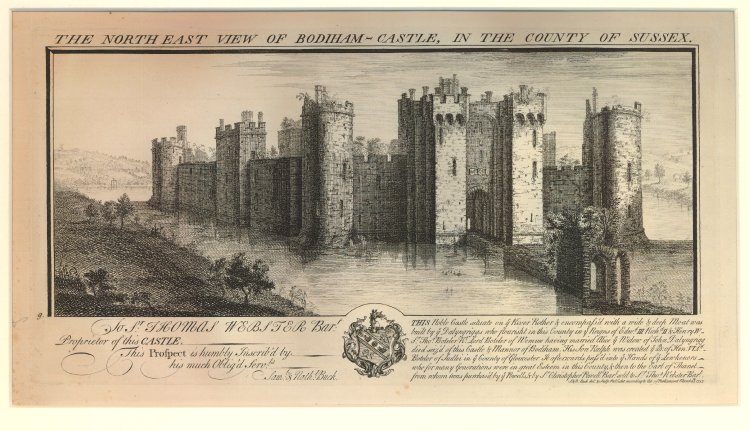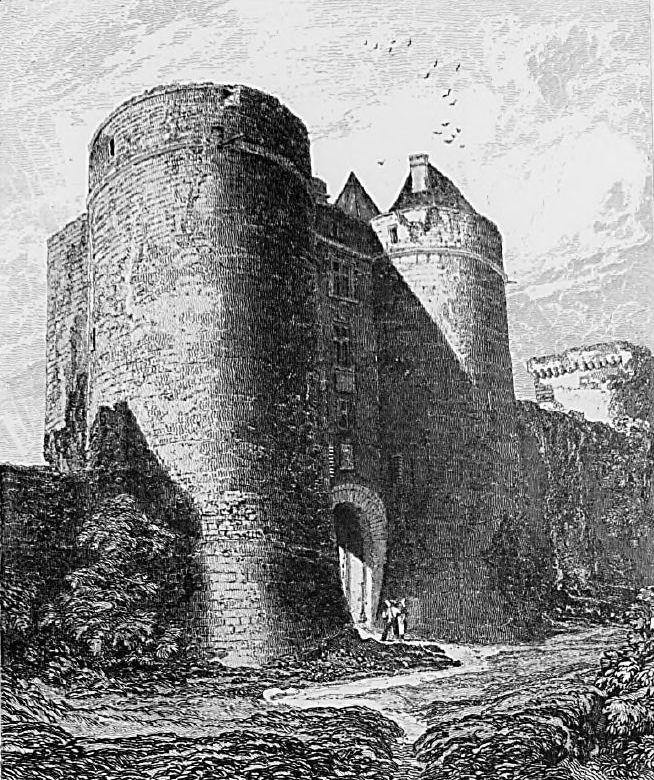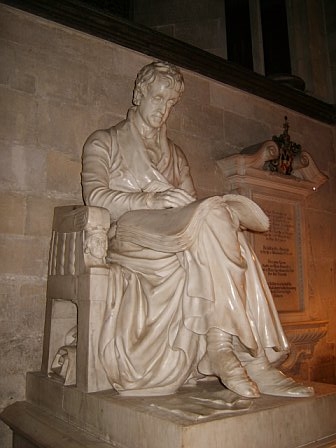|
Bradenstoke Abbey
Bradenstoke Priory was a medieval priory of Augustinian canons regular in the village of Bradenstoke, Wiltshire, England. Its site, in the north of the county about west of Lyneham, is on a ridge above the south side of Dauntsey Vale. In the 1930s the property was purchased by William Randolph Hearst and some of its structures were used by him for the renovation of St Donat's Castle near Llantwit Major, Wales. Foundation and four centuries of life The priory was founded in 1142 as the Augustinian priory of Clack, and dedicated to Saint Mary. It was well-sited on a high ridge near a holy well, with further springs nearby; there is some evidence that a chapel of the era of Henry I already existed at the holy well. The founder, Walter FitzEdward de Salisbury, was the son of Edward de Salisbury, a High Sheriff of Wiltshire; he gave lands for a priory as a daughter house of St. Mary's Abbey, Cirencester, according to its charter, "to serve God forever!". After the death of his ... [...More Info...] [...Related Items...] OR: [Wikipedia] [Google] [Baidu] |
Samuel And Nathaniel Buck
Samuel Buck (1696 – 17 August 1779) and his brother Nathaniel Buck (died 1759/1774) were English engravers and printmakers, best known for their ''Buck's Antiquities'', depictions of ancient castles and monasteries. Samuel produced much work on his own but when the brothers worked together, they were usually known as the Buck Brothers. More is known about Samuel than Nathaniel. Careers Samuel Buck was born in Yorkshire in 1696. After publishing some prints in that county he moved to London. With Nathaniel he embarked on making a number of series of prints of "antiquities", which consisted of ancient castles and former religious buildings in England and Wales. Starting in 1724, they travelled around these countries, and completed sets of prints for the regions of England by 1738 and for Wales between 1739 and 1742. These are commonly known as ''Buck's Antiquities''. During this time they also worked on a series of townscapes in England and Wales entitled ''Cities ... [...More Info...] [...Related Items...] OR: [Wikipedia] [Google] [Baidu] |
Wiltshire Victoria County History
The Wiltshire Victoria County History, properly called The Victoria History of the County of Wiltshire but commonly referred to as VCH Wiltshire, is an encyclopaedic history of the county of Wiltshire in England. It forms part of the overall Victoria County History of England founded in 1899 in honour of Queen Victoria. With eighteen volumes published in the series, it is now the most substantial of the Victoria County Histories. Overview A set of Wiltshire volumes was planned from the start; the authors engaged included Maud Davies, who began writing in 1906. However, the VCH central office ran into financial difficulty in 1908, and although work resumed in 1910 in ten counties, Wiltshire was not among them. In 1947 the Wiltshire project was revived, leading to publication of the first volume in 1953. For many years the project was chiefly funded by Wiltshire County Council and other Wiltshire local authorities and managed by the Wiltshire Victoria County History#Wiltshire Vict ... [...More Info...] [...Related Items...] OR: [Wikipedia] [Google] [Baidu] |
Henry II Of England
Henry II (5 March 1133 – 6 July 1189), also known as Henry Curtmantle (french: link=no, Court-manteau), Henry FitzEmpress, or Henry Plantagenet, was King of England from 1154 until his death in 1189, and as such, was the first Angevin king of England. King Louis VII of France made him Duke of Normandy in 1150. Henry became Count of Anjou and Maine upon the death of his father, Count Geoffrey V, in 1151. His marriage in 1152 to Eleanor of Aquitaine, former spouse of Louis VII, made him Duke of Aquitaine. He became Count of Nantes by treaty in 1158. Before he was 40, he controlled England; large parts of Wales; the eastern half of Ireland; and the western half of France, an area that was later called the Angevin Empire. At various times, Henry also partially controlled Scotland and the Duchy of Brittany. Henry became politically involved by the age of 14 in the efforts of his mother Matilda, daughter of Henry I of England, to claim the English throne, then occupied b ... [...More Info...] [...Related Items...] OR: [Wikipedia] [Google] [Baidu] |
William Marshal, 1st Earl Of Pembroke
William Marshal, 1st Earl of Pembroke (1146 or 1147 – 14 May 1219), also called William the Marshal (Norman French: ', French: '), was an Anglo-Norman soldier and statesman. He served five English kings— Henry II, his sons the "Young King" Henry, Richard I, and John, and finally John's son Henry III. Knighted in 1166, he spent his younger years as a knight errant and a successful tournament competitor; Stephen Langton eulogised him as the "best knight that ever lived." In 1189, he became the ''de facto'' earl of Pembroke through his marriage to Isabel de Clare, though the title of earl was not officially granted until 1199 during the second creation of the Pembroke earldom. In 1216, he was appointed protector for the nine-year-old Henry III, and regent of the kingdom. Before him, his father's family held a hereditary title of Marshal to the king, which by his father's time had become recognised as a chief or master Marshalcy, involving management over other Marshals and ... [...More Info...] [...Related Items...] OR: [Wikipedia] [Google] [Baidu] |
Cumbria
Cumbria ( ) is a ceremonial and non-metropolitan county in North West England, bordering Scotland. The county and Cumbria County Council, its local government, came into existence in 1974 after the passage of the Local Government Act 1972. Cumbria's county town is Carlisle, in the north of the county. Other major settlements include Barrow-in-Furness, Kendal, Whitehaven and Workington. The administrative county of Cumbria consists of six districts ( Allerdale, Barrow-in-Furness, Carlisle, Copeland, Eden and South Lakeland) and, in 2019, had a population of 500,012. Cumbria is one of the most sparsely populated counties in England, with 73.4 people per km2 (190/sq mi). On 1 April 2023, the administrative county of Cumbria will be abolished and replaced with two new unitary authorities: Westmorland and Furness (Barrow-in-Furness, Eden, South Lakeland) and Cumberland ( Allerdale, Carlisle, Copeland). Cumbria is the third largest ceremonial county in England by area. It i ... [...More Info...] [...Related Items...] OR: [Wikipedia] [Google] [Baidu] |
Cartmel Priory
Cartmel Priory church serves as the parish church of Cartmel, Cumbria, England (formerly in Lancashire). Priory The priory was founded in 1190 by William Marshal, created 1st Earl of Pembroke, intended for a community of the Augustinian Canons regular and was dedicated to Saint Mary the Virgin and Saint Michael. To support the new house, William granted it the whole fief of the district of Cartmel. It was first colonised by a prior and twelve canons sent from Bradenstoke Priory in Wiltshire. 14th century Between 1327 and 1347 a chapel with four traceried windows was provided by Lord Harrington in the south choir aisle; his tomb is in the building. The gatehouse, which apart from the church itself is the only surviving structure of the medieval priory, was built between 1330 and 1340. 15th and 16th centuries In the 15th century extensive work was undertaken, in part due to damage (believed to be from natural causes) in the northern part of the church. In the east end of the ch ... [...More Info...] [...Related Items...] OR: [Wikipedia] [Google] [Baidu] |
Earl Of Salisbury
Earl of Salisbury is a title that has been created several times in English and British history. It has a complex history, and is now a subsidiary title to the marquessate of Salisbury. Background The title was first created for Patrick de Salisbury in the middle twelfth century. In 1196 the title passed to Patrick’s granddaughter, Ela, who married William Longespée, an illegitimate son of Henry II the same year. Ela was predeceased by husband, son and grandson, and was succeeded by her great-granddaughter, Margaret Longespée. Margaret married Henry de Lacy, 3rd Earl of Lincoln, and their daughter Alice eventually became Countess of Salisbury, in 1310, and of Lincoln, in 1311. Alice had married Thomas, Earl of Lancaster, in 1294. When the Earl of Lancaster lost his titles and was executed for treason in 1322, the Countess surrendered all of her titles to the King, and the titles lapsed. The title was created for a second time in 1337 for William Montacute of the no ... [...More Info...] [...Related Items...] OR: [Wikipedia] [Google] [Baidu] |
Canons Regular
Canons regular are priests who live in community under a rule ( and canon in greek) and are generally organised into religious orders, differing from both secular canons and other forms of religious life, such as clerics regular, designated by a partly similar terminology. Preliminary distinctions All canons regular are to be distinguished from secular canons who belong to a resident group of priests but who do not take public vows and are not governed in whatever elements of life they lead in common by a historical Rule. One obvious place where such groups of priests are required is at a cathedral, where there were many Masses to celebrate and the Divine Office to be prayed together in community. Other groups were established at other churches which at some period in their history had been considered major churches, and (often thanks to particular benefactions) also in smaller centres. As a norm, canons regular live together in communities that take public vows. Their early ... [...More Info...] [...Related Items...] OR: [Wikipedia] [Google] [Baidu] |
Tonsure
Tonsure () is the practice of cutting or shaving some or all of the hair on the scalp as a sign of religious devotion or humility. The term originates from the Latin word ' (meaning "clipping" or "shearing") and referred to a specific practice in medieval Roman Catholic Church, Catholicism, abandoned by papal order in 1972. Tonsure can also refer to the secular practice of shaving all or part of the scalp to show support or sympathy, or to designate mourning. Current usage more generally refers to cutting or shaving for monks, devotees, or mystics of any religion as a symbol of their renunciation of worldly fashion and esteem. Tonsure is still a traditional practice in Catholicism by specific religious orders (with papal permission). It is also commonly used in the Eastern Orthodox Church for newly baptised members and is frequently used for Buddhism, Buddhist novices, Bhikkhu, monks, and Bhikkhunī, nuns. The complete shaving of one's head bald, or just shortening the hair, exists ... [...More Info...] [...Related Items...] OR: [Wikipedia] [Google] [Baidu] |
Cirencester Abbey
Cirencester Abbey or St Mary's Abbey, Cirencester in Gloucestershire was founded as an Augustinian monastery in 1117 on the site of an earlier church, the oldest-known Saxon church in England, which had itself been built on the site of a Roman structure. The church was greatly enlarged in the 14th century with addition of an ambulatory to the east end. The abbot became mitred 1416. The monastery was suppressed in 1539 and presented to Roger Bassinge. In the twelfth and thirteenth centuries, the abbey fostered the successful writers Robert of Cricklade and Alexander Neckam. They were supported in their work by other canons, including Walter of Mileto and Alexander's nephew Geoffrey Brito. Burials *Regenbald *Thomas Holland, 1st Duke of Surrey and wife Joan Stafford (daughter of Hugh Stafford, 2nd Earl of Stafford Hugh may refer to: *Hugh (given name) Noblemen and clergy French * Hugh the Great (died 956), Duke of the Franks * Hugh Magnus of France (1007–1025), co-King ... [...More Info...] [...Related Items...] OR: [Wikipedia] [Google] [Baidu] |
High Sheriff Of Wiltshire
This is a list of the Sheriffs and (after 1 April 1974) High Sheriffs of Wiltshire. Until the 14th century, the shrievalty was held ''ex officio'' by the castellans of Old Sarum Castle. On 1 April 1974, under the provisions of the Local Government Act 1972, the title of Sheriff of Wiltshire was retitled as High Sheriff of Wiltshire.Local Government Act 1972: Section 219 at legislation.gov.uk, accessed 28 April 2020: ”Sheriffs appointed for a county or Greater London shall be known as high sheriffs, and any reference in any enactment or instrument to a sheriff shall be construed accordingly in relation to sheriffs for a county or Greater London". Sheriff To 1400 *1066: Edric *1067–1070: Philippe de Buckland *1085: Aiulphus the Sheriff *1070–1105: < ...[...More Info...] [...Related Items...] OR: [Wikipedia] [Google] [Baidu] |
Edward Of Salisbury
Edward of Salisbury was a nobleman and courtier (''curialis''), probably part Anglo-Saxon, who served as High Sheriff of Wiltshire during the reigns of William I, William II and Henry I. The ''Chronicon Abbatiae Rameseiensis'' (1293) names him as a justice during the reign of Edward the Confessor. He may have been sheriff as early as 1070, he was certainly in that office by 1081, and perhaps carried on there until as late as February or March 1105,Morris (1918), 151. when he appears in a long list of sheriffs who witnessed a charter of Henry I. He probably served Henry as a chamberlain. As sheriff Edward received the reeveland and a certain pence pertaining the shrievalty as personal property, under certain obligations.Morris (1918), 156. A different man, Walter Hosate, possessed the shrievalty of Wiltshire in 1107. According to Domesday Book (1086), Edward held five hides of land at Salisbury from Bishop Herman in 1086. His manors in Wiltshire included Wilcot, where he had "a ... [...More Info...] [...Related Items...] OR: [Wikipedia] [Google] [Baidu] |






